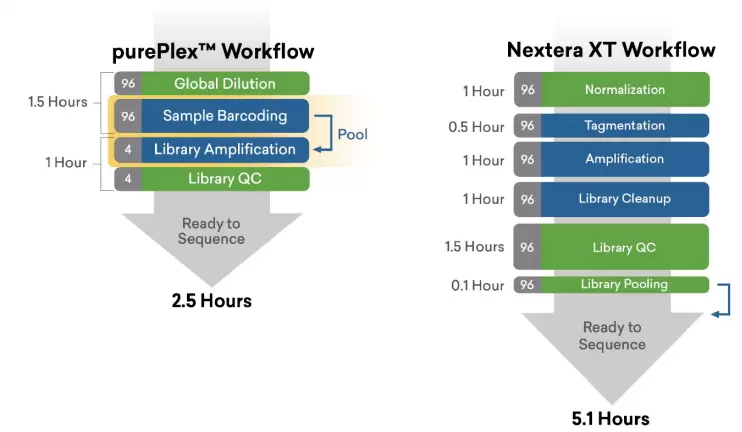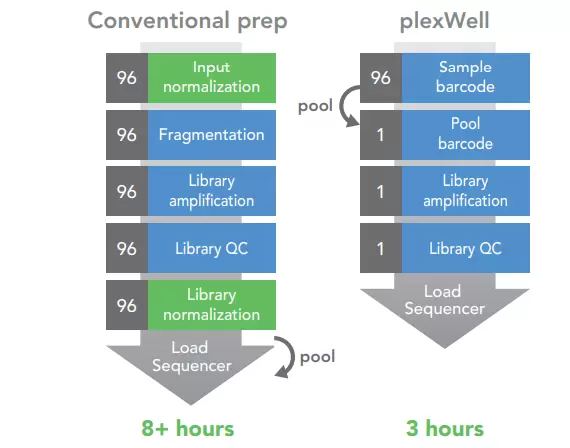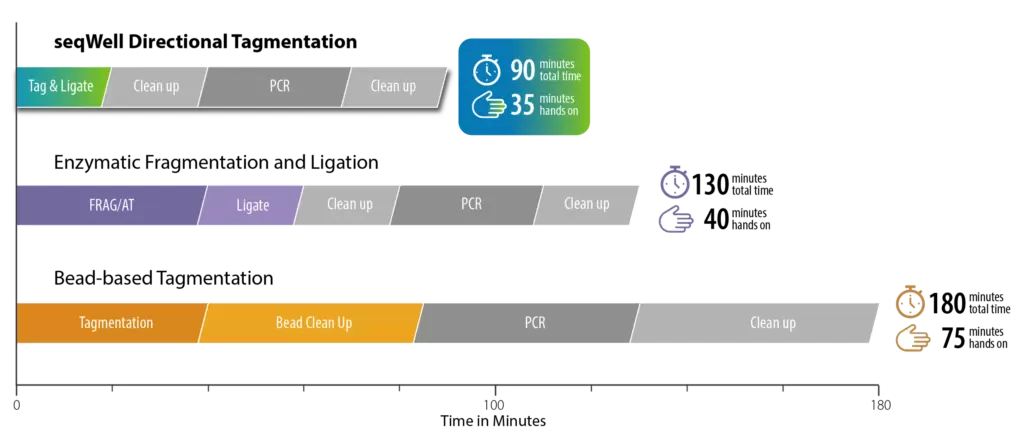
NGS DNA Library Preparation Kits
Get your data faster with streamlined workflows
Better Transposase | Better Libraries | Better NGS
Accelerate your NGS workflows with a truly multiplexed library preparation solution engineered for speed, consistency and scalability. seqWell’s advanced tagmentation-based technology enables the rapid generation of high-quality libraries from hundreds to thousands of samples, dramatically reducing time to data.
Tagmentation, the technique of simultaneous fragmenting and tagging (ligating NGS adapter sequences) of DNA is excellently suited to replace traditional library preparation methods that use complex and lengthy protocols that can limit the reach of NGS.
- Workflow simplicity: Simultaneous DNA tagging (barcoding) and fragmenting streamlines NGS library preparation method
- Tunability: Transposition reactions have defined stoichiometry - the number of events in a reaction can be controlled to produce a defined size and yield of library
- Flexibility: Tagmentation can be utilized in a wide range of reaction conditions or sample types

Tagmentation: Unfragmented genomic DNA is simultaneously cleaved and tagged using TnX transposase.
Tagmentation-based NGS DNA Library Preparation Kits
Our partner seqWell has developed highly innovative NGS DNA Library Preparation Kits which harness the power of tagmentation.
- Easier and faster workflows
- High level of multiplexing
- Automation-friendly
- Significant cost and plastics savings
- Auto-normalization of read counts and insert size over 10-fold input range
- TnX: Next Generation Transposase with less GC bias and increased activity
ExpressPlex
The ExpressPlex 2.0 Library Preparation Kits are designed for rapid turnaround of plasmid, amplicon, or synthetic construct sequencing.They use the power of the Next Generation Transposase TnX for reduced bias and improved coverage uniformity. The TnX transposase-based workflow combines protocol simplicity with high-performance library preparation and generates sequence-ready libraries from extracted samples in less than half a day. The kits support automation and flexible reaction volumes.
purePlex
A streamlined workflow was developed for the purePlex™ DNA Library Preparation Kits. With seqWell's patented Tn5 transposase-based chemistry where simple molecular tagging steps add dual indexes early on in the library prep process, they enable pooling of samples prior to any bead cleanups or amplification steps. A distinct advantage of the purePlex workflow is the elimination of sample and library normalization which reduces the QC and labor cost compared to traditional UDI workflows.

plexWell
The plexWell™ system for scalable true multiplexing utilizes a transposase to selectively tag DNA samples in a unique sequential manner. Samples are sequentially tagged with Illumina P7 and P5 primers resulting in normalized libraries with unique barcode combinations. The sequential tagging process provides more control of each step versus other transposon methods and less prone to bias and input DNA variations. The plexWell workflow saves hours over conventional library preperation by eliminating the need for time-intensive DNA normalization and library quantitation.

MosaiX
MosaiX is a high-performance DNA library preparation kit that incorporates TnX into a novel directional tagmentation workflow. The workflow simplicity, the reduced insertion bias of TnX, and the performance benefits of ligation are combined to produce high complexity libraries.

Long Plex
The LongPlex™ Long Fragment Multiplexing Kit fragments genomic DNA to the range of 7-10 kb while simultaneously adding barcodes in a rapid transposase-based enzymatic method. The initial fragmentation and barcoding steps take only ~35 minutes in a plate-based workflow.
Tagify
Tagify™ loaded transposase reagents for tagmentation-based NGS library preparation enable simple, scalable, and reliable unique molecular identifier (UMI) additions or gene editing QC analysis. Choose between i5 UMI Adapter- or Custom-loaded transposase and accelerate your variant calling or gene editing efforts with peace of mind.